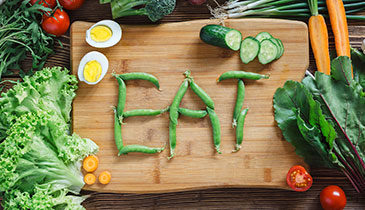 Your kitchen might be under the cruel reign of the food industry. When you remove the sugary, processed foods that hold your weight and health hostage and replace them with real, whole foods, you have a chance to stage a revolution and reclaim your kitchen.
Your kitchen might be under the cruel reign of the food industry. When you remove the sugary, processed foods that hold your weight and health hostage and replace them with real, whole foods, you have a chance to stage a revolution and reclaim your kitchen.
Getting the obstacles to weight loss and health out of your way will transform your kitchen into a place of true nourishment and healing.
In fact, taking back our kitchens and embracing the act of cooking real food is probably the single most important thing that any one person can do to create a healthy, sustainable food system. It is also a magical alchemy that transforms individual ingredients into ambrosia and pleasure.
My philosophy is to “Eat Real Food.” So the best thing to do immediately is to take an afternoon to hunt and gather in your kitchen. Be merciless, and throw out any products that are not real food. Toss all highly processed, factory-manufactured Frankenfoods. Keep and going forward, choose only fresh vegetables, fruits, whole grains, beans, nuts, seeds, and lean animal proteins such as fish, chicken, and eggs.
Now, I understand that not everyone is ready for or wishes to undertake such a dramatic change. That doesn’t mean you need to take an either-or approach and succumb to the processed, sugary foods that contribute to diabesity.
A few simple upgrades can transform your diet without radically altering your life. While simple, these seven replacements can create dramatic changes in your diet that don’t feel restrictive or “diet-ish.”
- Replace breakfast with a protein smoothie. Most people start the day wrong, having dessert for breakfast or skipping this most important meal altogether. A protein shake makes an easy replacement to stoke your metabolic fire to burn more calories during the whole day, accelerating weight loss. You can load a shake with superfoods, proteins, healthy fats, and phytonutrients that will keep your blood sugar balanced and your energy high throughout the day. Plus, they are very filling and satisfying— no worries here about going hungry. Protein shakes sustain you and help you control your appetite throughout the day.
- Upgrade your meat and eggs. Conventional meat and eggs often come loaded with hormones, antibiotics, from animals fed with grain and other foods that definitely do not belong in their diets. Look for animal products that are pasture-raised, grass-fed, and antibiotic-, hormone-, and pesticide-free. Go on a low-mercury diet by sticking with small, wild, or sustainably farmed fish. By the way, you don’t need to stick to just egg whites. Yolks contain important vitamins and fats needed for brain and mood function.
- Replace gluten starches with green vegetables. Gluten is a protein found in wheat, barley, rye, spelt, and oats. It has been around since we began cultivating grains thousands of years ago (still relatively new in the human diet). But 50 years ago, the type of gluten changed as we created new strains of wheat (genetically altered dwarf strains I call Frankenwheat), and this has created a veritable epidemic of problems, including a 400 percent increase in celiac disease and a dramatic rise in gluten sensitivity, affecting about eight percent of the population. While gluten-free grains are best, all grains (including breads, cereals, and snacks) — even gluten-free ones— can spike blood sugar and insulin. To break the addiction cycle, we need to shut down insulin production as much as possible. An easy way to do that is simply substitute another leafy or cruciferous vegetable for what would normally constitutes a starch on your plate. You can easily do this when dining out as well. If your entree includes a baked potato, simply ask your server to substitute sautéed spinach.
- Replace bad oils for good oils. Corn, soybean, canola, and sunflower oils contain inflammatory omega-6 fats and currently make up 10 percent of our calories. Instead, stick to extra virgin olive oil or extra virgin coconut butter (also known as coconut oil). Extra virgin olive oil contains polyphenols, which are powerful anti-inflammatory and antioxidant compounds. Olive oil has been shown to reduce the risk of heart disease as much as or more than statins. Coconut butter or oil is a powerful cellular fuel and also contains anti-inflammatory fats such as lauric acid, the same fat found in breast milk. For high-heat cooking, grape seed oil is also safe.
- Replace bad fats for healthy fats. The standard American diet (SAD, indeed) contains a massive amount of pro-inflammatory fats that keep you sick, tired, fat, and inflamed. Make the leap to anti-inflammatory healthy fats. Have one serving of a healthy fat at all meals, which might be ¼ avocado, wild-caught salmon, grass-fed beef, or nut or seed butter such as almond or cashew.
- Replace snacks with nuts. Get rid of the sugary, processed snacks and keep nuts in your pantry instead. They have been proven to help with weight loss and reduce the risk of diabetes. They are also a great snack because they are full of protein, fiber, minerals, and good fats. Buy raw or lightly toasted unsalted nuts. Avoid nuts that are fried or cooked in oils. The best are almonds, walnuts, macadamia nuts, hazelnuts, and pecans. Stick with one or two handfuls for a snack once or twice a day. But be careful, nuts have a tendency to raise blood sugar if you binge on them. Remember a serving is 10 to 12 nuts or a good handful.
Replace coffee for green tea. Coffee can interfere with your liver’s detoxification mechanisms, makes you less insulin sensitive, and its caffeine content revs up your stress hormones. Make the switch to green tea and stick to one to three cups a day. The small amount of caffeine won’t hurt and the antioxidants will heal.




